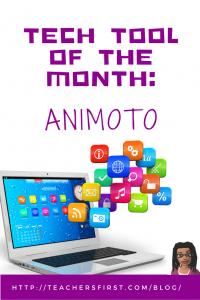 From time to time I learn about or rediscover a tech tool that is really versatile. When that happens, members of the TeachersFirst team know that for at least the next month they will find the tool strategically placed in emails, mentioned in conversation, and suggested for inclusion on all types of projects that we are working on. I just can’t help myself. This past month I rediscovered Animoto. So I thought I would share it with you here on the blog as well.
From time to time I learn about or rediscover a tech tool that is really versatile. When that happens, members of the TeachersFirst team know that for at least the next month they will find the tool strategically placed in emails, mentioned in conversation, and suggested for inclusion on all types of projects that we are working on. I just can’t help myself. This past month I rediscovered Animoto. So I thought I would share it with you here on the blog as well.
If you aren’t already familiar with Animoto, you need to be. This versatile tool turns photos and video clips into slideshows. As a teacher, you can use the slideshows as learning objects. Students, on the other hand, can create slideshows to demonstrate their understanding of a concept. The slideshow doesn’t have to be just pictures and video clips either. You can add captions to the pictures or put short sentences or phrases in between pictures to underscore your thought or concept. You could even use a tool like Vocaroo to record an MP3 file to upload as the audio track instead of using the music Animoto provides. There are a number of ways to infuse this tool into your instruction.
There are a few caveats that teachers need to be aware of when investigating and planning to use this tool:
- There are several different types of accounts. Teachers should apply for an Educator Account. When approved, this will upgrade your account to Animoto Plus for free. You will be able to make longer videos (free accounts only get 30 seconds) without the Animoto watermark. The educator account will also allow you to share the plus version with 50 student accounts.
- The Animoto terms of service do not allow for children under 13 to have their own accounts. Account must be “owned” by a parent or teacher. They provide a workaround for creating student accounts. You can see it here. This video gives some compelling reasons to use this workaround for students over 13 years old as well. Need additional help with this? This slide presentation will walk you through the process.
- Remember to brush up on Digital Citizenship and Copyright with your students. Animoto requires that you have the appropriate rights to pictures, video clips and music that you upload for slideshows. Try to learn about Creative Commons and find a few places with copyright-friendly media before you turn your students loose.
- Assessment of creative projects needs to be as objective as possible. Remember to use rubrics when assigning Animoto projects. The TeachersFirst website has more information about rubrics.
Here are a few resources that will help you as you explore Animoto:
- Franklin Township Public Schools Tutorial
- Creative Commons Tutorial by Meredith Keene
- Copyright Friendly Media wiki
- Animoto Lesson Strategy Guide from ReadWriteThink
Here are a few lesson ideas to get you started:
When introducing Animoto at the MySciLife PLC meeting this month I suggested this project:
MTV Cribs is coming to visit your “crib” (also known as habitat). Create an Animoto slideshow describing the tour of your home/habitat. You may use video, images, and text. Post a link to your video on the class stream.
What do you think? How will you use Animoto in your classroom?

